In early May, from 8 am until 1.30 pm, anyone entering The Complex art space in Dublin could encounter six industrial sewing machines that appeared to be self-operating. Needles were going up and down, pedals were pushed by invisible forces. It was the beginning of the day for Dubliners but over 8,000 kilometres away from the Irish capital, workers in a textile factory in Bangalore, India, were in full production mode, manipulating fabric, pressing upon the foot pedals of the machines, crafting the clothes some of us would soon be wearing. Their gestures and efforts in the factory were mirrored faithfully and in real-time by the sewing machines in Dublin.
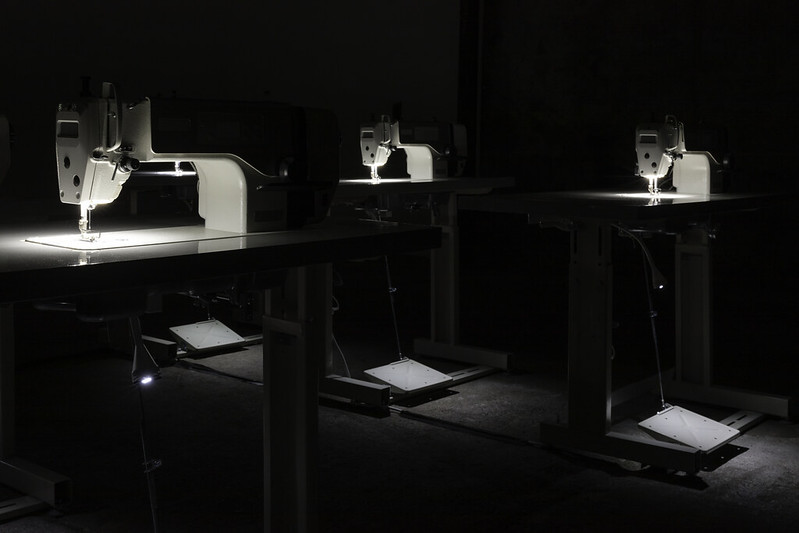
Kerry Guinan, The Red Thread, 2022. Installation view at The Complex in Dublin
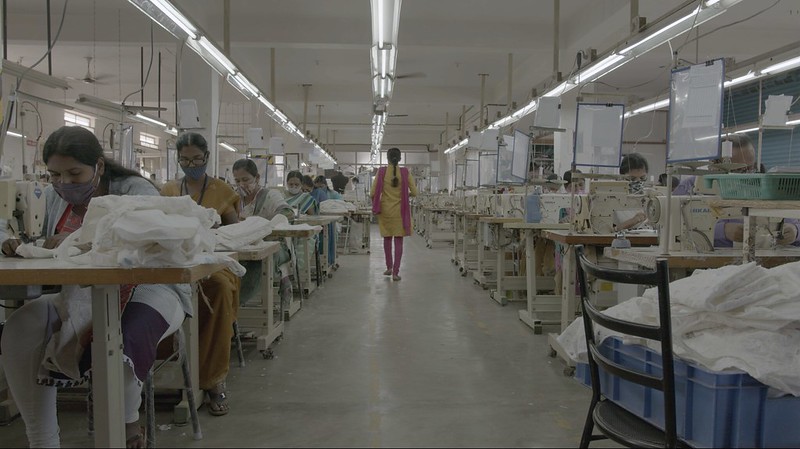
Kerry Guinan, The Red Thread (video still), 2022
The Red Thread Documentation
Created by Kerry Guinan, The Red Thread was a live performance that digitally linked the sewing machines in Dublin to the ones operated by the workers / performers: each time they pressed the foot pedal, the data was transmitted in real-time to the machines in Dublin, which reproduce the movement using motors. With the performance, the women’s daily, attentive gestures took on a new significance: they fleshed out the human element buried under the magnitude of the globalised fashion industry. The exhibit also made tangible the social links that bind us together: the invisible connections between people at opposite ends of supply chains.
The Red Thread reflects Guinan’s interest in the social relations hidden at the base of the economy. Throughout its production, the networked performance facilitated encounters between people. It started with the infrastructure of trust that enabled the artist to get in touch -through strings of friends of friends of acquaintances- with other artists, experts and finally, with the factory director and the workers in India. And it ended with gallery-goers suddenly feeling a sense of connection with the skilled workers who cut, sew and embroider their clothes.
Kerry Guinan, The Red Thread, 2022
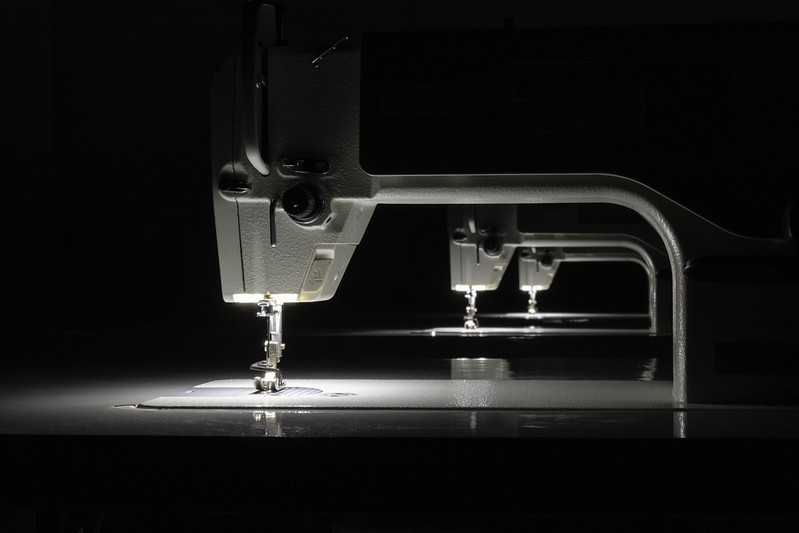
Kerry Guinan, The Red Thread, 2022. Installation view at The Complex in Dublin
Kerry Guinan is a conceptual artist working to critique labour and property relations under neoliberal capitalism. Her practice crosses the disciplines of performance, delegated performance, installation, public art, photography and digital media to bring these relations into sharp focus. I got a chance to speak to her a few days after the closing of the exhibition:
Hi Kerry! You orchestrated a live performance where so many elements could have gone wrong from the very beginning: you could have struggled to find a workshop in India, you could have met with workers who were not interested in participating in the performance, the opening hours of the gallery were a bit unusual…. And then there was the technology of course. Was there any moment you felt you didn’t have any control over it? What were the most challenging moments and aspects of the work for you?
During the first few months, when I started working on this project, I did worry that I was delusional. It seemed like such a farfetched idea. However, I really like a challenge and planning things through, so I enjoyed the initial process of problem-solving, devising backup plans, conceptualising smaller size versions of the project in case too many things went wrong, etc. For the first few months, the idea felt quite fantastical.
Now that it is over and it ran so successfully, I look back and find it remarkable that it did go according to my initial plan, I met all the deadlines and I didn’t have to use any backup options. There was not really any moment when I thought it was going to fall apart. Although it could have!
The moment when the factory Pret Interpret Clothing confirmed their involvement is when I started to feel that it was really going to happen. That was back in October 2021. Usually, garment factories are quite protective about who they let access their premises. Their consent felt like a mark of trust on their part because I wasn’t offering anything in return, except a chance for them to take part in this unique art project with me. Building that relationship was a big success but of course, I couldn’t take that for granted, I had to work to maintain their trust.
Once I had the factory on board, the project took over my life and this fantastical idea just became my daily job.
As for the technical side: I worked with a wonderful team of fabricators across the world: Robert Collins who had worked with the Science Gallery in Dublin and is now doing a PhD in post-human design at Umeå University in Sweden, Frank Prendergast whose creative fabrication company is Space Forms in Dublin and Sai Mulpuru who is a professor at the Srishti College of Design in Bangalore and who also previously worked with the Science Gallery in Bangalore. They are all so skilled that I never once doubted their ability to deliver on the technical aspects of the project.
But there were all these contextual factors that were threatening us. Situating the technology in an active workplace required a lot of problem-solving. Even the clothes of the garment workers themselves were impacting my technology. The technology we used to record the movement of the foot pedals in the factory were laser sensors connected to ESP 32 micro-controllers. If any fabric or dust were to land on the laser sensor it would crash the data. The women in the factory wear long saris and as they move their legs, the fabric creates a slight breeze under the table, which would gather dust and debris that could land on our sensors and disrupt the data. So Sai, who supervised the project for its whole run at the factory, had to clean the sensors once an hour to negotiate that problem. The shoes they wear in the factory are mostly sandals and during rehearsals, they were slipping off and landing on our devices. I had to ask the workers to take off their shoes at the table and place them in a certain place. The sewing machines break regularly during production, and as the factory electrician fixes them, he might move the table an inch. This would also interfere with our data because we had coded precise measurements for the relative distance between each foot pedal and sensor. In the end I had to write instructions for every different role in the factory, asking them to make slight changes to their working habits in order to protect our devices there.
And there were much broader technical problems that were totally outside of my control. Like the fact that Bangalore suffers from regular power cuts, which would shut the factory down for a few minutes. Add to the picture the fact that we were working in the context of the COVID-19 pandemic and at any point a new wave could have swept across either continent and caused the factory or the gallery to close.
In the end, it almost felt magical that it worked perfectly for the six-day run in spite of all the things that could have gone wrong. It almost felt like everyone gave so much love and commitment to the project that the world paused just for us to let those 6 exhibition days happen.
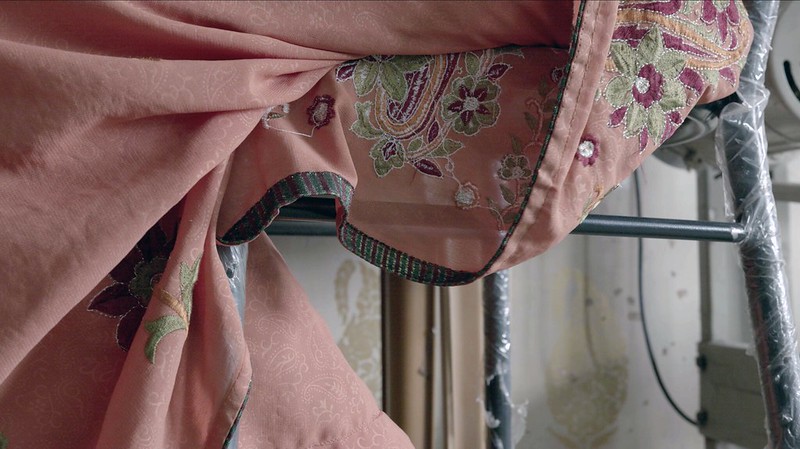
Kerry Guinan, The Red Thread (video still), 2022
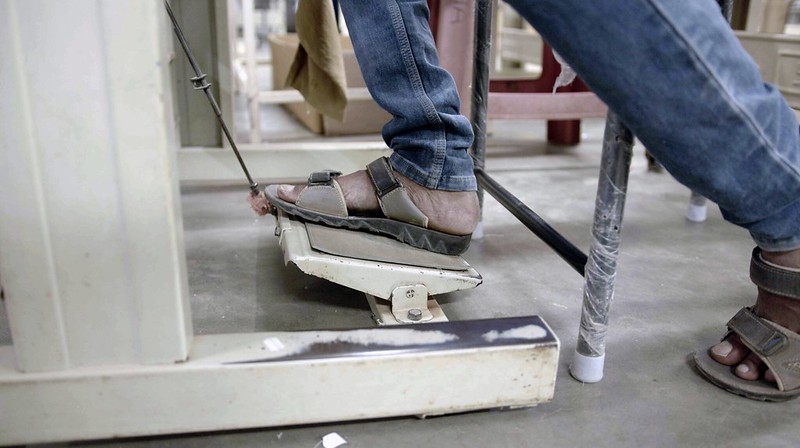
Kerry Guinan, The Red Thread (video still), 2022
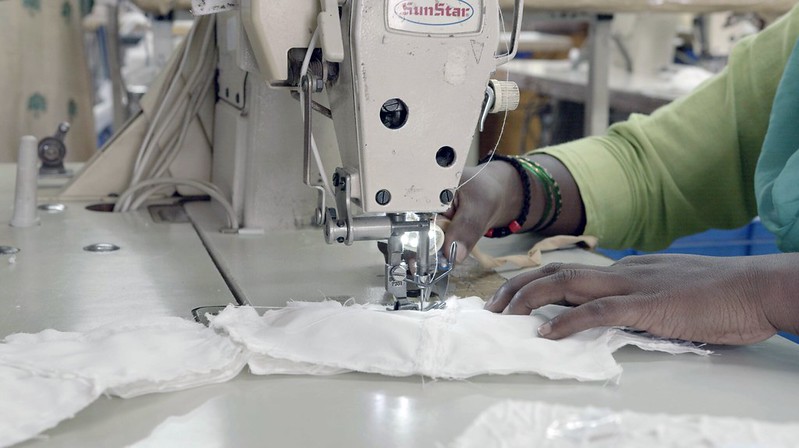
Kerry Guinan, The Red Thread (video still), 2022
You went to Bangalore in February in order to meet the participants in the stitching department of Pretinterpret Clothing, learn about their work, explain the project and get feedback from them. Why was it so important for you to meet them? Did these conversations modify or guide the development of the project in any way?
My initial contact was with the employer who came on board in October. After that, I wanted to meet the workers in the factory to explain the project to them myself and invite them to take part. I also wanted to ensure they understood the capacity of the technology that we were using because there are significant technological gaps between myself and the workers in the factory. Most of them wouldn’t have home computers, just mobile phones for instance. I was bringing these new devices into their workplace and I felt a responsibility to demonstrate the technology and explain what it was doing. I had one on one conversations with the stitching workers about what it feels to be monitored and watched because monitoring adds pressure to the workplace, whatever you are doing. It instantly changes your behaviour when you feel you are being watched. I wanted to have those discussions with the workers.
It was nice to arrive and sense that people were excited about the project. I had a meeting with all 75 workers in the factory where I introduced myself and my work, I explained Ireland, a bit about my culture and we demonstrated the technology. It was exciting that we could bring a camera into the factory, it was a big indication of trust from the factory director. I then spoke to the stitching workers one on one and learnt about their work and their relationship to their work. It was moving to hear about the deep respect that the workers have for their machines. I spoke with a worker who had placed a red rose on top of her machine. She explained to me that she respected the machine that gave her work and allowed her to feed herself and her children. The rose was a sign of respect for the machine.
There were cultural, and socio-economic gaps to be overcome in these conversations. I had a lot of consultations with an artist from Bangalore, Bakula Nayak, prior to visiting the factory. I also worked with Emily Waszak, a socially-engaged textile artist and anti-racist organiser and Kit Braybooke, a digital anthropologist. One of the problems was that I felt a lot of reverence towards me on account of my being white. I didn’t want my status or race to impact consent, I wanted to make sure that their consent was genuine. So I couldn’t accept the initial responses of ‘yes, yes, yes.’ That is why I spoke to the people one on one. The process of conversing with people had to go through an interpreter because the workers speak the local language Kannada, not English. I worked with the interpreter to try and understand the hidden meanings behind some of their words to make sure that they were genuine when they were consenting. When people started saying “No” to me, it felt like one of the biggest achievements of the project. It was a sign that I had created a space for autonomous decision-making in that workplace setting.
I think that the effect of the project was that it made the workers’ every day life feel just a little bit more extraordinary. For the opening of the show, I had invited the workers to send a message of sorts that I would play to the Irish audience during the speeches. I was amazed when I received that video back. It was not just a speech,they had created a whole symbolic video. They had rolled down a red carpet down the factory floor and recorded the workers walking in line, saluting the camera and then sitting down at their performance/work stations. They also made a video of the whole stitching department holding a big bundle of red thread together. That was one of the most beautiful moments in the project for me. It was so special to be able to bring their voices to the opening and feel the excitement across continents.
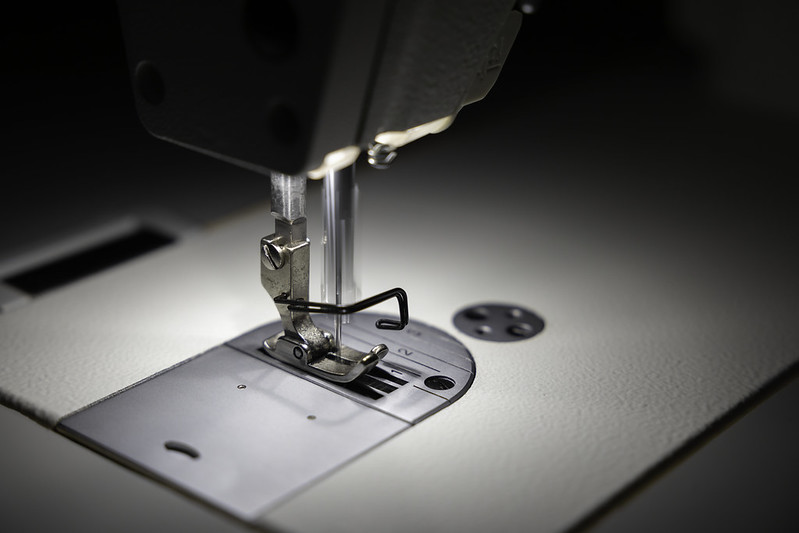
Kerry Guinan, The Red Thread, 2022. Installation view at The Complex in Dublin
How about the public in Dublin? What was their reaction to The Red Thread? Were they talking about the fact that the textile industry is one of the most polluting industries in the world?
During the whole making of the project, I was thinking about all these dominant narratives that we hear about the textile industry in the media. Of all the industries in the world, I think people are most aware of the textile industry and its problems. If I were to ask someone to describe the inside of a garment factory, they’d be able to do it. But they might not be able to do the same for other industries. I was aware that people would come to the show with all those pre-conceived imagery and narratives already in their heads. I wondered if I should respond to those narratives somehow, but ultimately I decided to keep the focus on my initial idea, which was to show the presence of human workers across the world. The piece benefited from that simplicity of message because, instead of looking at the industry from these big systematic, top-down perspectives, it gave a much more personal, human perspective, the everyday presence of people operating the machines in their workplace.
An almost universal response to the show was that people had a pre-conceived idea of what the installation was going to sound like. I think of this installation as a sound and movement installation. It produces an almost improvised, incidental live score and choreography that is totally unique at any given moment depending on what is happening in the factory. People – including myself, originally – tended to envision an experience where all 6 machines would be running constantly and loudly, because we have these images in our minds of busy, noisy factories. However, 80% of the stitching work doesn’t consist of operating the machine, it’s doing stuff around that activity: arranging the fabric, threading the needle, doing hand work, waiting for the piece to be passed forward, etc. Which I think says something about how we imagine labour, how so much of the work goes unconsidered and unseen.
The installation, in contrast to people’s expectations, was very quiet, gentle and intimate. Most of the time, a visitor entering the space would encounter only 1 or 2 machines running at any given time, for bursts of a few seconds, followed by a long pause, and then a different machine might start. You could be walking through a very quiet installation and then suddenly a machine would start behind you and stop before you even had a chance to turn around. It was really bringing out that individuality of each worker and the particular piece of the garment they were making, which was defining how much weight they would put on the foot pedal, which was defining how much movement you would experience in Ireland, how fast the needle was running, for how long. Their skills were being translated in the differences of movement on each machine in Ireland. So it was really dynamic, and people were surprised to encounter a much more personalised, intimate experience of people just doing their ordinary job, rather than a noisy industrial soundscape.
The work wasn’t closing in on any particular narrative, it was open-ended and it began from that perspective of the worker. Some people told me that it made them feel a bit more conscious of the clothes on their skin, the labour that went into making them. One person remarked that his clothes felt heavier on his body after being in the space. I had heated the gallery slightly in reference to the temperatures that the workers were in. It ended up being a very bodily experience.
The exhibition also featured a short film by Anthony O’Connor. Could you say a few words about the film? Was it there to give more presence to the workers?
Yes, I wanted to humanise the workers so that they were not just represented by ghostly lights and movements but that a bit of their faces, the context in which they were working was shown. Many people visiting the show in Ireland would never have heard of Bangalore so I wanted the film to give some context and de-abstract the work. I also wanted to give value to the international cooperation that made the project happen. If The Red Thread is about demystifying the labour of the garment industry, then the film is about demystifying the labour of making The Red Thread. I wanted to bring out the skills and expertise that everybody brought to the project, just as I was bringing out the skills and expertise that the factory operators have.
However, I didn’t want the film to close the project within any particular narrative. Anthony did a great job at keeping the film insightful, providing context to the work, but also allowing that open-endedness to be protected.
I’ve always been interested in bringing documentary into my practice because I work in social contexts, so for me the artwork you see in the gallery is only half the art, the other half exists out there in the world, and I’ve always wondered about the best way of capturing that. On the other hand, I don’t fully trust documentary as a medium and I didn’t want to simply create a promotional film for the work. I wanted the film to be honest and, if necessary, critical. That’s why I worked with Anthony O’Connor, because I knew him to be not only an excellent filmmaker but also someone with a critical mind whom I felt would be honest about his observations.
I took on the role of Producer for the film and he was the Director of it. I had a final say on the edit but in the end I didn’t make any major changes because I felt he represented the project perfectly.
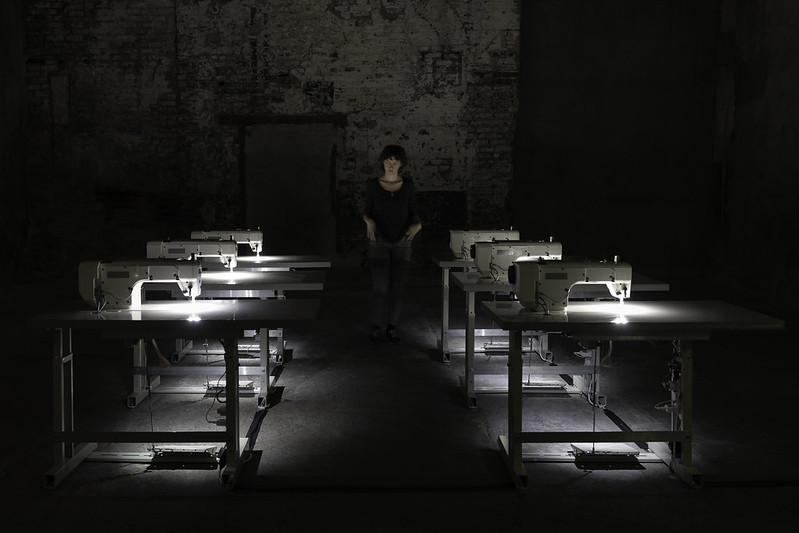
Kerry Guinan, The Red Thread, 2022. Installation view at The Complex in Dublin
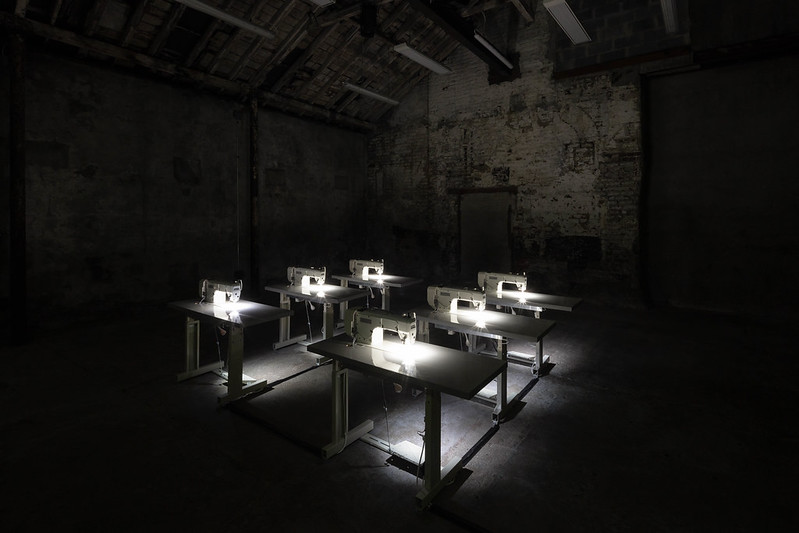
Kerry Guinan, The Red Thread, 2022. Installation view at The Complex in Dublin
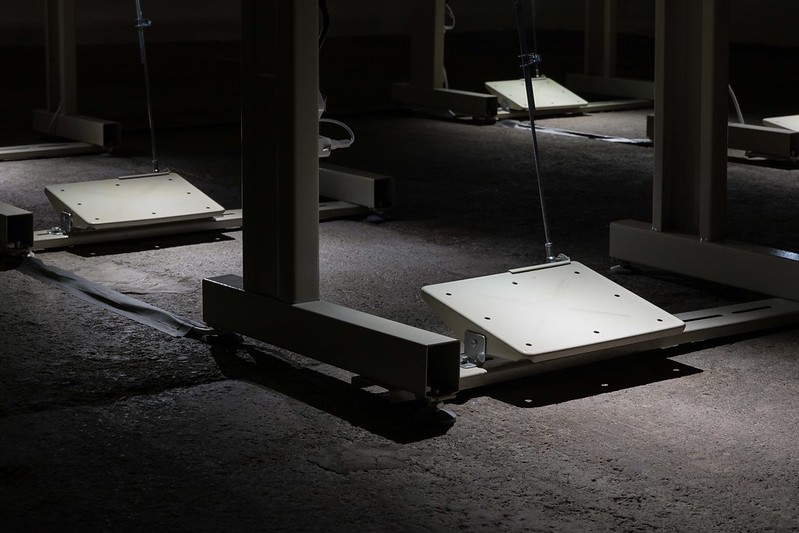
Kerry Guinan, The Red Thread, 2022. Installation view at The Complex in Dublin
What guided your artistic decision to keep the sewing machines in a (mostly) dark room?
That wasn’t my original intention. The gallery building is an old industrial space and they’ve kept the original brick walls and strip fluorescent lighting native to the industrial use of the building. At first, I wanted to use that original lighting, which would be close to that of the factory in India. During rehearsals, when I saw the piece in action in a brightly lit room, I realised that the subtleties of the movements could be missed because the movements of the foot pedals are so gentle, it’s often a matter of milimetres. That detail, that subtlety would have been lost in a brightly lit industrial space, especially because the other moving part in the installation is the needle and the needle really commands attention. The powerful sharp object is moving at speed and it is closer to eye level so I was worried that people would walk in the space and miss the human body that was represented in the space through the foot pedal. So after several trials, I decided to keep the room dark and spotlight the two moving parts – the needle and the pedal – which drew the eye to a part of the gallery you usually do not notice, which is the floor. That lighting brought out something poetic in the work, it made the absence of the workers’ bodies feel all the more present in its ghostly effect.
Some of your previous works, in particular Portraits and Artists, seem to have similar concerns. They explore invisible (or invisibilised) workforce, connections with people living far away, outsourced work, etc. What draws you to these issues?
My work has always been interested in systems of capital, labour and property. And it has always had that political motivation. I’m particularly interested in issues of labour. Aside from my practice, I’m a co-founder and a Chairperson of Praxis, which is a trade union for artists in Ireland.
Over the past few years, I’ve been working on a PhD at the Limerick School of Art & Design. The PhD is examining Relational Art practice. Relational Art being art that is produced with other people’s participation. I’ve been seeking to redefine that term ‘relational,’ not as the voluntary relationships that are created with other people in art but as the involuntary relationships that bind us to each other, creating the complex social reality that we live in. I wanted to use the process of Relational Art to bring these relations into the fore. It starts with the assumption that these relationships exist and I just need to find a way of making these connections at a personal level and then bring them into view through art.
I was moved to explore our relationships on a global scale. In Ireland, I personally feel so alienated from so much of the essential international labour that supports my everyday existence. I have an interest in the role that vast distance (in geographic as much as in cultural and economic terms) plays in entrenching feelings of alienation and keeping us feeling disconnected from each other when we actually are highly connected. I want to make works that bring that essential labour into light. I’m also careful that the work itself is reflective of my own role in these systems. I’m not making works about these labourers per se, it’s more about my, and our, relationship to them in the Global North. It’s about what binds us together. People from all over the world are connected through complex economic systems that we do not feel we have much of a say in. In the feat of achieving the work, of producing it, I am making these connections real. I hope The Red Thread demonstrates the potential we have to cooperate with each other and carry out seemingly impossible ideas on a really big scale, even using the same technologies that in some ways alienate us. Most of The Red Thread was built on WhatsApp.
Thanks Kerry!
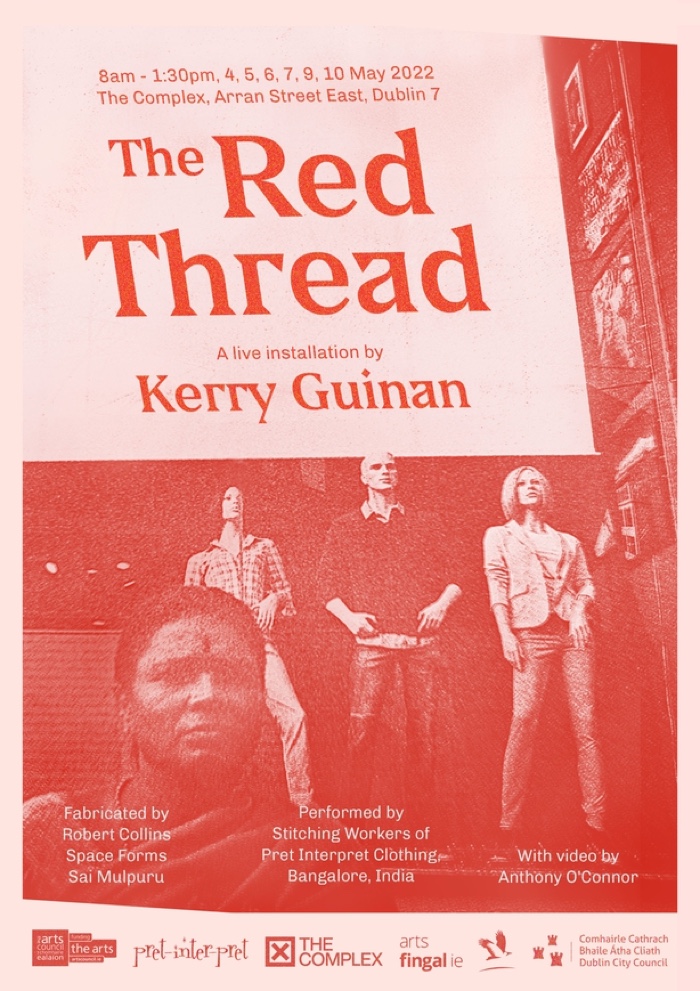
The Red Thread is a project by Kerry Guinan. Production team: Pret Interpret Clothing India, Robert Collins, Space Forms, Sai Mulpuru, Bakula Nayak, Anthony O’Connor, Aisling Murray, and Emily Waszak. Supported by the Complex Dublin, the Arts Council of Ireland, Fingal Arts Office, and Dublin. City Arts Office.
Video: Anthony O’Connor. Soundtrack: Natalia Beylis.
